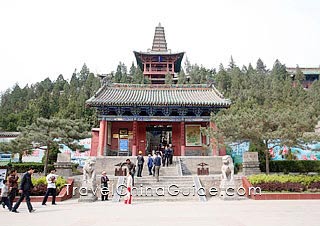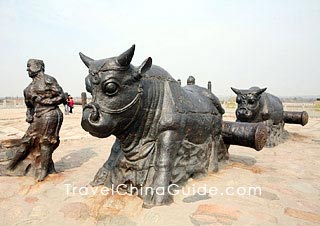Yuncheng Travel Guide
Yuncheng Facts
Chinese Name: 运城 (yùn chéng)
Population: 5,372,600
Area: 13,968 square kilometers (2,025 square miles)
Location: in the southwest of Shanxi Province, north China
Administrative Division: 1 district (Yanhu); 10 counties (Ruicheng, Linyi, Wanrong, Xinjiang, Jishan, Wenxi, Xiaxian, Jiangxian, Pinglu, Yuanqu); 2 county-level cities (Yongji, Hejin)
Area Code: 0359
Zip Code: 044000
GDP (2019): CNY 156.29 billion (USD 22.65 billion)
Hometown of General Guan Yu & Flourishing Salt City
Yuncheng City is located in southwestern Shanxi Province, neighboring Linfen and Jincheng within the province. It is separated from Shaanxi Province and Henan Province by the Yellow River. Yuncheng is 200 kilometers (124 miles) from Xi'an and Luoyang, and 380 kilometers (236 miles) from Taiyuan, the capital of Shanxi Province. It is easy to reach Xi'an in 1 hour, Taiyuan in 2 hours and Beijing in 5 hours by bullet train. Yuncheng is the only city established for developing the salt industry in China. Now Yuncheng salt is mainly used for salt carving, salt lamp and bath salt. Many tourists go to experience floating and bathing in black mud in the Yuncheng Salt Lake.
The stories of Guan Yu, a famous general of the Kingdom of Shu (221 - 263 AD), are widely spread in Yuncheng. He was born here and respected by others for his loyalty, benevolence, and integrity. For Chinese people, he is also a patron god. The Temple of Guan Yu is incense-imbued homage to Guan Yu. Besides, the Yongle Palace and Guanque Tower are the most well-known scenic spots in Yuncheng.
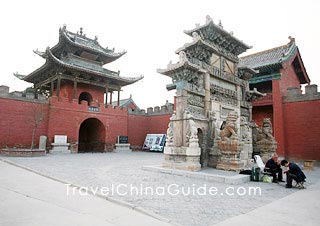 |
| Temple of Guan Yu |
Yuncheng Attractions - Things to Do
![]() Yongle Palace: It is a grand Taoist temple covering an area of eighty thousand square meters (20 acres). It stands in the Longquan Village 3 kilometers (1.9 miles) north of Ruicheng County. The temple is especially famous for the precious murals of the Yuan Dynasty (1271-1368).
Yongle Palace: It is a grand Taoist temple covering an area of eighty thousand square meters (20 acres). It stands in the Longquan Village 3 kilometers (1.9 miles) north of Ruicheng County. The temple is especially famous for the precious murals of the Yuan Dynasty (1271-1368).
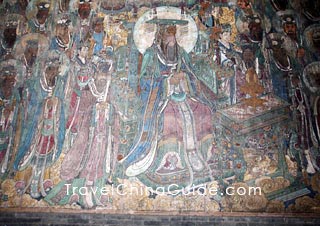 |
| Yongle Palace |
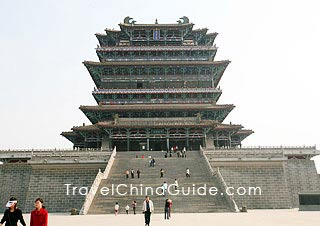 |
| Guanque Tower |
|
|
How to Get to Yuncheng
Yuncheng Guangong Airport is 11 kilometers (6.8 miles) northeast of the city proper. So far, it operates doemstic flights to/from about 35 cities such as Beijing, Shanghai, Guangzhou, Shenzhen & Chengdu and 1 international flight to/from Bangkok. Visitors can take airport shuttle bus and bus line 13 & 18 to travel between the airport and downtown.
Yuncheng's central bus station has moved to the north outskirt of the city in Shilichangjie which is about 3 kilometers (1.9 miles) from the downtown area.
Yuncheng Railway Station is close to the city center, with a distance of about 3 km (1.8 mi). Bus line 14, 33, 12, 18 and so on are available between the station and other areas in the city.![]() See more Beijing - Yuncheng Train, Xi'an - Yuncheng Train
See more Beijing - Yuncheng Train, Xi'an - Yuncheng Train
Weather
The city enjoys a temperate continental monsoon climate. Average temperature in the coldest January falls between -1 and 6 degrees centigrade (30.2 and 42.8 degree Fahrenheit), and in the hottest July remains between 24 and 28 degrees centigrade (75.2 and 82.4 degree Fahrenheit). The frost period of Yuncheng weather may last from mid-October to late March. It is torrid in summer and a bit warmer in winter than other cities in Shanxi. May to October are suitable for people to tour around.
Yuncheng Travel Tips
![]() History: This is a time-honored city, one of the oldest birthplaces of the Chinese nation. Tracks of human life in this area can be traced back to 1.8 million years ago. It was the seat of the capital of the first slave dynasty in Chinese history, Xia Dynasty (21st - 16th century BC). In the Qin Dynasty (221BC-206BC), it was administered under the Hedong Shire. Although administrative divisions in this region altered frequently in the following two thousand-odd years, it was habitually referred to as Hedong, meaning east of the Yellow River.
History: This is a time-honored city, one of the oldest birthplaces of the Chinese nation. Tracks of human life in this area can be traced back to 1.8 million years ago. It was the seat of the capital of the first slave dynasty in Chinese history, Xia Dynasty (21st - 16th century BC). In the Qin Dynasty (221BC-206BC), it was administered under the Hedong Shire. Although administrative divisions in this region altered frequently in the following two thousand-odd years, it was habitually referred to as Hedong, meaning east of the Yellow River.![]() Physical Features: The southeastern and northwestern areas here are lined with the Zhongtiao Mountain and Emeiling Mountain. Between the two mountains lies the Yuncheng Basin with an average altitude of 350-500 meters (1148-1640 feet). The Yellow River flows along the western and southern edges of the city.
Physical Features: The southeastern and northwestern areas here are lined with the Zhongtiao Mountain and Emeiling Mountain. Between the two mountains lies the Yuncheng Basin with an average altitude of 350-500 meters (1148-1640 feet). The Yellow River flows along the western and southern edges of the city.![]() Special Local Products: Jishan jujube, Wenxi Boiled pancake, Ruicheng sesame flakes, Jishan fried dough twist
Special Local Products: Jishan jujube, Wenxi Boiled pancake, Ruicheng sesame flakes, Jishan fried dough twist
